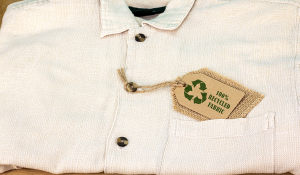Sustainability Initiatives
Sustainable Fashion, Fabrics and Design
Sustainable fashion refers to a holistic approach to clothing and textile production that seeks to minimize the negative environmental and social impacts associated with the fashion industry. It encompasses various practices and principles aimed at creating a more ethical and environmentally friendly fashion ecosystem. The key objectives of sustainable fashion include reducing waste, conserving natural resources, promoting fair labor practices, and fostering a more responsible and conscious consumer culture.
Key Aspects of Sustainable Fashion
Environmental Sustainability: Sustainable fashion aims to reduce the environmental footprint of clothing production. This includes using eco-friendly materials, reducing water and energy consumption, and minimizing pollution. Sustainable fashion brands often opt for organic, recycled, or renewable materials and implement environmentally friendly production processes.
Ethical Labor Practices: Ensuring fair wages, safe working conditions, and ethical treatment of workers throughout the supply chain is a fundamental aspect of sustainable fashion. This includes efforts to eliminate child labor, forced labor, and exploitation in the fashion industry.
Slow Fashion: Sustainable fashion encourages a shift away from the fast-paced, disposable fashion model. It promotes the concept of “slow fashion,” which emphasizes quality over quantity, longevity in clothing design, and the idea of investing in timeless, durable pieces rather than constantly buying and discarding cheap, trendy items.
Circular Economy: Sustainable fashion promotes circularity, where clothing is designed with recycling and reuse in mind. This involves recycling textiles, upcycling old garments into new products, and encouraging consumers to return used clothing for resale, repair, or recycling.
Transparency: Brands committed to sustainable fashion are often transparent about their supply chains, production methods, and sourcing of materials. This transparency helps consumers make informed choices and hold brands accountable for their practices.
Reduced Waste: Efforts are made to reduce waste at every stage of the fashion lifecycle, from design and production to distribution and disposal. This includes minimizing fabric waste, using zero-waste patterns, and encouraging responsible consumer behavior, such as clothing repair and donation.
Innovation: Sustainable fashion encourages innovation in materials and processes, seeking alternative, eco-friendly materials and techniques for dyeing, printing, and finishing textiles.
Consumer Education: Sustainable fashion advocates for educating consumers about the environmental and social impact of their clothing choices. It promotes conscious consumer behavior, encouraging individuals to make more sustainable choices when purchasing clothing.
Collaboration: Many sustainable fashion initiatives involve collaboration between designers, brands, manufacturers, and consumers to collectively address the challenges facing the fashion industry.
Overall, sustainable fashion seeks to create a fashion industry that is regenerative, socially responsible, and environmentally conscious. It recognizes the need to balance style and aesthetics with responsible and ethical practices to address the environmental and social challenges associated with the fashion industry.

What are "Sustainable Fabrics"?

Sustainable fabrics are textiles that are produced in an environmentally and socially responsible manner, with the goal of minimizing their negative impact on the planet and people. These fabrics are designed to address various sustainability concerns associated with conventional textile production, such as excessive water usage, chemical pollution, energy consumption, and exploitation of labor. Sustainable fabrics are a key component of the broader sustainable fashion and textile industry, which seeks to create more eco-friendly and ethical alternatives to traditional clothing and textile materials.
What Are Some Characteristics and Types of Sustainable Fabrics?
Organic Cotton: Organic cotton is grown without synthetic pesticides or genetically modified organisms (GMOs). It relies on natural methods for pest control and soil health, reducing the environmental impact of cotton production.
Hemp: Hemp is a versatile and fast-growing plant that requires minimal water and pesticides. It can be used to make durable and eco-friendly textiles, including hemp fabric and hemp-based blends.
Tencel (Lyocell): Tencel is a fiber made from sustainably sourced wood pulp, usually from eucalyptus or beech trees. It’s produced in a closed-loop process, which minimizes chemical waste and water usage.
Bamboo: Bamboo fabric is made from the pulp of bamboo plants. Bamboo is fast-growing and requires less water than cotton. However, the production process can vary in terms of sustainability, depending on whether it’s chemically or mechanically processed.
Recycled Fabrics: These fabrics are made from recycled materials, such as plastic bottles, discarded clothing, or industrial waste. Examples include recycled polyester (rPET) and recycled nylon.
Soy Silk (Soybean Fiber): Soy silk is made from soybean waste, typically a byproduct of soybean oil production. It’s a biodegradable and renewable textile material.
Linen: Linen is made from the fibers of the flax plant, which is naturally resistant to pests and requires less water than cotton. It’s a durable and breathable fabric.
Wool: Sustainable wool comes from ethically treated sheep and uses eco-friendly practices in the farming and processing stages.
Alpaca and Llama: Fibers from alpacas and llamas can be sustainable when raised and sheared using ethical and environmentally responsible methods.
Peace Silk (Ahimsa Silk): Peace silk is produced without killing the silkworm, as it allows the pupa to complete its metamorphosis and emerge as a moth before harvesting the silk.
Nettle Fiber: Nettle plants can be used to make textiles and are grown without the need for synthetic chemicals.
Sustainable fabrics are often associated with reduced water consumption, lower chemical use, biodegradability, and fair labor practices in their production. However, it’s important to note that the sustainability of a fabric depends not only on the raw material but also on the entire supply chain, including cultivation, processing, and transportation. Certification standards like GOTS (Global Organic Textile Standard) and OEKO-TEX can help consumers identify textiles that meet specific sustainability criteria.
Unless other sources are listed, original content is provided by ChatGPT. ChatGPT may produce inaccurate information about people, places, or facts. #TextileCreation #fashionrecycling #upcyclingtextile #manufacturingclothing #yarn #polyester #wasteproblem #clothingawareness #textileawareness #globaltrade #education
